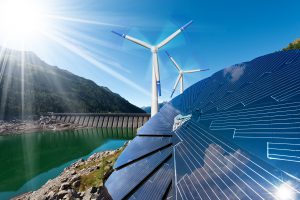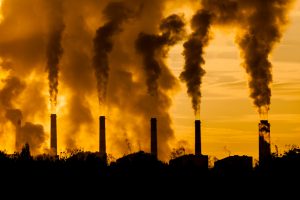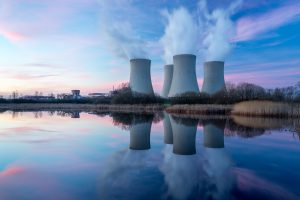Last week, a Greenpeace Unearthed analysis claimed that China’s carbon emissions rose 4% in the first quarter of 2018, and cautioned that the country is likely to see its biggest annual carbon emissions surge in seven years. The increase was largely fuelled by growth in coal, gas and oil consumption resulting from the government’s continued economic stimulus, which has fired-up furnaces and kilns in the country’s heavy industries.
The findings highlight the continuation and acceleration of a trend from last year, when carbon emissions were estimated to have risen 1.5% year-on-year.
As China is the world’s largest carbon emitter, many observers are wondering whether its transition to a low-carbon economy is happening fast enough. It’s crucial that China reduce its carbon emissions if the world is to meet the Paris Agreement target of keeping global temperature rise well below 2 degrees Celsius before the end of this century.
To understand what the recent rise in carbon emissions means for China’s efforts to peak carbon emissions by 2030, chinadialogue invited three of China’s top climate experts to respond.
Dr Jiang Kejun, senior researcher at the Energy Research Institute, National Development and Reform Commission and expert for the IPCC’s upcoming ‘Special Report on Global Warming of 1.5 Degrees’
The relatively fast growth of China’s carbon emissions in the first quarter is only temporary and does not represent the annual trend. There are reasons to believe that China’s total carbon emissions in 2018 will be at a similar level, or even lower, than last year.
The up-tick in industrial output and electricity demand for heating were the major drivers of growth in coal consumption and carbon emissions in the first quarter. Heating demand is seasonal, and the industrial production surge stabilised after March. Last winter’s air quality was relatively good thanks to favourable weather conditions. The government loosened some restrictions on industrial production, which led to a “compensational surge” by industries that were previously suppressed, particularly in the Beijing-Tianjin-Hebei metropolitan region. Now that industrial inventories have reached relatively high levels, production will have to slow down.
In the long run, as the Chinese economy undergoes structural changes, investment in infrastructure is set to decline gradually, leaving fewer drivers for significant increases in carbon emissions in the future. What happened in the first quarter will not change the long-term trend, and we are still positive about China reaching a peak in emissions way before 2030. In fact, a recent study by the Energy Research Institute, Tsinghua University, and other partners shows that China’s carbon emissions are likely to peak between 2020-2022.
Dr Zou Ji, president of Energy Foundation China
The latest increase in coal consumption and CO2 emissions suggests that the country's economic “new normal” [of slower economic growth], which started in 2012, has touched bottom and is beginning to enter a phase of recovery. Energy and electricity demand will likely grow in this period, which will not be met entirely with renewables given the barriers that still exist in the electricity market. Those factors have led to a rise in carbon emissions. It clearly shows that China is still in the “pre-peak” era, in which the decoupling between economic growth and carbon emissions is incomplete.
However, there is something unique about the latest round of economic recovery. For one, thanks to China’s growing middle class, consumption-driven use of energy (including for transportation, heating, cooling and other household uses), is reshaping China’s energy consumption patterns. Secondly, the electrification of industrial production adds to the increase in overall power demand, even though actual output from heavy industry is kept more-or-less flat. As a large share of China’s electricity is still generated by coal, electrification at this stage means more coal burning and carbon emissions.
We still have confidence that China's carbon emissions will peak early
That being said, we still have confidence that China's carbon emissions will peak early. Our model suggests that when China's per capita gross domestic product reaches US$ 14,000, carbon emissions will see a turning point. If the Chinese economy can maintain a relatively high annual growth rate of 6.5% or more without reliance on carbon or energy-intensive industries, then there is a high likelihood that emissions will peak between 2025 and 2030.
2018 marks the mid-point of the 13th Five-Year Plan (2016-2020). The first quarter surge sends a reminder that emissions reduction will not be easily achieved unless targeted efforts are sustained in the areas of pollution control, renewables deployment and energy efficiency.
Dr Yang Fuqiang, senior advisor on Energy and Climate for the Natural Resources Defense Council's China Programme
The analysis is consistent with our own estimation that China’s carbon emissions increased by 4-5% in the first quarter. We expect that by the end of 2018 the carbon emissions increase will stabilise at around 2%. Annual coal consumption is expected to be on the same level as last year or see a mild increase of no more than 1%.
One of China’s Paris Agreement commitments is to peak CO2 emissions before 2030. Prior to the end of 2017, China’s annual carbon emissions last peaked in 2014. Quarter one figures in 2018 and projections for the rest of the year indicate that there is an increased possibility of this year’s carbon emissions exceeding 2014 levels.
Data from April gives us some hope. Increases in electricity, coal and oil consumption have all slowed after quarter one and ahead of the summer peak season. If China is to achieve its goal of peaking its carbon emissions early, the government should step up its efforts to keep coal consumption under control. It should also pay attention to rising oil consumption and general power consumption in the industrial and service sectors, and households, which are increasingly shaping China’s future carbon trajectory.








